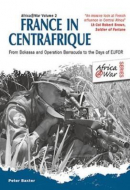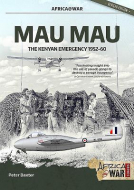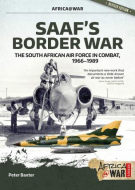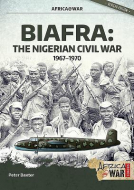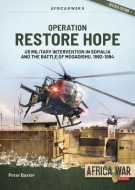
- Agriculture
- Architecture & Design
- Arts & Photography
- Biography
- Business
- Calendars and Diaries
- Childrens (All)
- Childrens (Illustrated)
- Childrens (Picture flats)
- Childrens (Te Reo)
- Classics
- Cooking, Food & Drink
- Craft & Hobbies
- Design (Art / Graphics)
- Design (Interiors)
- Education
- Fashion
- Fiction & Literature
- Fiction - Young Adult
- Gift Ideas
- Health & Wellbeing
- History
- Home & Garden
- Humour & Gift
- Instead of a Card Poems
- Military
- Music
- New Zealand
- NZ (History)
- NZ (Landscapes)
- NZ (Pictorial)
- Poetry
- Reference
- Religion & Faith
- Science & Nature
- Sport & Recreation
- Stationery
- Taschen : 40th Anniversary Edition
- Taschen : BA Basic Art
- Taschen : BU Bibliotheca Universalis
- Te Reo Māori
- Transport
- Travel
Peter Baxter (5)
|
France in Centrafrique (Africa@War36)
ISBN: 9781912866823 Author: Peter Baxter Publisher: Helion & Company France in Centrafrique explores the early colonial and post-colonial history of French Equatorial Africa with a particular emphasis on the role of the Central A... France in Centrafrique explores the early colonial and post-colonial history of French Equatorial Africa with a particular emphasis on the role of the Central African Republic in the Second World War and the Free French Movement. One of the key figures to emerge from this period, and a man who would shape the modern destiny of the Central African Republic, was Jean-Bédel Bokassa. Bokassa served alongside the Free French under General Charles de Gaulle and later in the metropolitan French military as an NCO in Indo-China. The narrative traces his ascent from these humble beginnings to his position as one of the region's most notorious dictators, exploring both his excesses of violence and personal aggrandizement and the role played by France and the wide-reaching Foccart intelligence network in his rise and fall. Baxter examines the past and present relationship of France with her erstwhile African colonial possessions, giving substance to the cause and effect of the many French interventions and the play of various individual personalities, both French and African, and how this has affected the current complexion of the region and its ongoing relationship with France. The book traces the overt and covert French military actions in the region, the rise of internal violence and insecurity and the increasing involvement of the international community in the series of coups and counter-coups that characterized the 1990s and the new century. Featured are Operation Barracuda, Operations Almandin I, II and II, Operation Boali and the various regional, international and European regional interventions. Bind: paperback Pages: 72 Dimensions: 210 x 297 mm Publication Date: 04-09-2019 |
$49.99 |
|
|
Mau Mau (Africa@War 41)
ISBN: 9781912866878 Author: Peter Baxter Publisher: Helion & Company The Second World War forever altered the complexion of the British Empire. From Cyprus to Malaya, from Borneo to Suez, the dominoes began to fall within a decad... The Second World War forever altered the complexion of the British Empire. From Cyprus to Malaya, from Borneo to Suez, the dominoes began to fall within a decade of peace in Europe. Africa in the late 1940s and 1950s was energized by the grant of independence to India, and the emergence of a credible indigenous intellectual and political caste that was poised to inherit control from the waning European imperial powers. The British on the whole managed to disengage from Africa with a minimum of ill feeling and violence, conceding power in the Gold Coast, Nigeria and Sierra Leone under an orderly constitutional process, and engaging only in the suppression of civil disturbances in Nyasaland and Northern Rhodesia as the practicalities of a political handover were negotiated. In Kenya, however, matters were different. A vociferous local settler lobby had accrued significant economic and political authority under a local legislature, coupled with the fact that much familial pressure could be brought to bear in Whitehall by British settlers of wealth and influence, most of whom were utterly irreconciled to the notion of any kind of political handover. Mau Mau was less than a liberation movement, but much more than a mere civil disturbance. Its historic importance is based primarily on the fact that the Mau Mau campaign was one of the first violent confrontations in sub-Saharan Africa to take place over the question of the self-determination of the masses. It also epitomized the quandary suffered by the white settler communities of Africa who had been promised utopia in an earlier century, only to be confronted in a post-war world by the completely unexpected reality of black political aspiration. This book journeys through the birth of British East Africa as a settled territory of the Empire, and the inevitable politics of confrontation that emerged from the unequal distribution of resources and power. It covers the emergence and growth of Mau Mau, and the strategies applied by the British to confront and nullify what was in reality a tactically inexpert, but nonetheless powerfully symbolic black expression of political violence. That Mau Mau set the tone for Kenyan independence somewhat blurred the clean line of victory and defeat. The revolt was suppressed and peace restored, but events in the colony were nevertheless swept along by the greater movement of Africa toward independences, resulting in the eventual establishment of majority rule in Kenya in 1964. Bind: paperback Pages: 56 Dimensions: 210 x 297 mm Publication Date: 30-11-2019 |
$49.99 |
|
|
SAAFs Border War (Africa@War 43)
ISBN: 9781912866885 Author: Peter Baxter Publisher: Helion & Company South African Mirages and Cuban MiG-21s dogfighting over Cuito Cuanavale, the largest tank battle on African soil since El Alamein; Puma troopships shot out of ... South African Mirages and Cuban MiG-21s dogfighting over Cuito Cuanavale, the largest tank battle on African soil since El Alamein; Puma troopships shot out of the skies by Strela missiles and RPG-7 rockets; Alouette III gunships hovering menacingly above Koevoet tracker-combat teams as they close in for the kill; Hercules and Transall transports disgorging their loads of Parabats over Cassinga; suicidal helicopter hot-extractions of Recce operators deep in enemy territory; and a lone Alouette pilot who disobeyed orders and under intense ground fire evacuated a critically wounded soldier ... such is the story of the South African Air Force, the SAAF, over the 23-year period 1966-1989, the period of conflict that became known as the 'Border War'. Set against the backdrop of the Cold War, the SAAF was effectively South Africa's first line of defence against Soviet expansionism in southern Africa. That the Soviets, through their surrogates - the Cuban military, Angola's FAPLA and Namibia's SWAPO - sought a communist regime in South Africa is indisputable, as too was the SAAF's skill, quality, determination and capability to defeat the best Soviet air defences of the time. This account covers all the major operations that the SAAF was involved in, from Operation Blouwildebees, the opening salvo of the conflict at Omgulumbashe, South West Africa in 1966 to the final curtain, Operation Merlyn, the so-called April Fool's Day 'war' of 1989 when the SAAF and Koevoet, almost alone, frustrated SWAPO's last throw of the dice with its illegal invasion of South West Africa. In this account, highlighting such operations as Reindeer, Bootlace/Uric, Sceptic, Protea, Daisy, Askari, Moduler, Hooper and Packer, among many, as well as the ongoing methodological operations like Lunar, Maanskyn, Donkermaan and Butterfly, Baxter examines and brings to life the squadrons and aviators that fought in both counter-insurgency and conventional warfare roles. Besides an extensive selection of rare photographs, the book features a comprehensive section on camouflage and markings and 11 pages of colour aircraft profiles and insignia by noted SAAF authority William Marshall, making this title especially useful for modelers. Bind: paperback Pages: 72 Dimensions: 210 x 297 mm Publication Date: 30-11-2019 |
$49.99 |
|
|
Biafra (Africa@War 45)
ISBN: 9781912866892 Author: Peter Baxter Publisher: Helion & Company Nigeria was a unique concept in the formation of modern Africa. It began life as a highly lucrative if climatically challenging holding of the Royal Niger Compa... Nigeria was a unique concept in the formation of modern Africa. It began life as a highly lucrative if climatically challenging holding of the Royal Niger Company, a British Chartered Company under the control of Victorian capitalist Sir George Taubman Goldie. It was handed over to indigenous rule in 1960 with the best of intentions and a profound hope on the part of the British Crown that it would become the poster child of successful political transition in Africa. It did not. One of the signature failures of imperial strategists at the turn of the 19th century was to take little if any account of the traditional demographics of the territories and societies that were subdivided, and often joined together, into spheres of foreign influence, later evolving into colonies, and finally into nation states. Many of the signature crises in post-colonial Africa have owed their origins to this very phenomenon: incompatible and mutually antagonistic tribal and ethnic groupings forced to cohabit within the indivisible precincts of political geography. Congo, Rwanda/Burundi, Sudan and many others have suffered ongoing attrition within their borders as historic enmities surge and boil in restless and ongoing violence. Such was the case with Nigeria in the post-independence period. The traditions and practices of the Islamic north and the Christian/Animist south, and even within the multiplicity of ethnic division in the south itself, proved to be impossible to reconcile. The result was an immediate centrifuge away from the centre, complicated by the vast infusion of oil revenues and the inevitable explosion of corruption that followed. All of this created the alchemy of civil war and genocide, which erupted into violence in 1967 as the eastern region of Nigeria attempted to secede. The war that followed shocked the conscience of the world, and revealed for the first time the true depth of incompatibility of the four partners in the Nigerian federation. This book traces the early history of Nigeria from inception to civil war, and the complex events that defined the conflict in Biafra, revealing how and why this awful event played out, and the scars that it has since left on the psyche of the disunited federation that has continued to exist in the aftermath. Bind: paperback Pages: 72 Dimensions: 210 x 297 mm Publication Date: 31-12-2019 |
$49.99 |
|
|
Operation Restore Hope (Africa@War 57)
ISBN: 9781915070579 Author: Peter Baxter Publisher: Helion & Company The end of the Cold War introduced an altered global dynamic. The old bond of East/West patronage in Africa was broken, weakening the first crop of independent ... The end of the Cold War introduced an altered global dynamic. The old bond of East/West patronage in Africa was broken, weakening the first crop of independent revolutionary leadership on the continent who no longer had the support of one or other of the superpowers. With collapse of the Soviet Union, all this changed. The question of global/strategic security devolved into regional peacekeeping and peace enforcement, characterized primarily by the Balkans War, but also many other minor regional squabbles across the developing world that erupted as old regimes fell and nations sought to build unity out of the ashes. In Africa the situation was exacerbated by an inherent tribalism and factionalism that had tended to be artificially suppressed by powerful, often military, dictatorships, generally unconcerned with the needs and requirements of an oppressed population. No more striking example of this can be found than Somalia. One of the only effective armed resistance movements mounted against European colonization in Africa took place in Somalia, which was suppressed only after enormous military expenditure. The crisis in Somalia that began to take shape with the ouster of military leader Mohammed Siad Barre during the early years of the 1990s forced both the United States and the United Nations to adapt their collective military policy toward the challenges of peacekeeping, and peace enforcement, in a human environment only dimly understood, extremely austere in terms of local infrastructure and with a warring clan leadership. This book tells the story of the international intervention that took place in Somalia, the successes, failures and lessons learned. Many broad assumptions were made based on an unclear understanding of the dynamics of a regional conflict, coupled with the necessity for the first time in modern military history to balance political necessities with military. The crisis in Somalia set the tone for military intervention in a post-Cold War world, and although the same mistakes have been depressingly often repeated, the complexion of global military organization changed dramatically as a consequence of this episode. Bind: paperback Pages: 72 Dimensions: 210 x 297 mm Publication Date: 15-02-2022 |
$49.99 |


